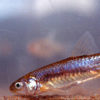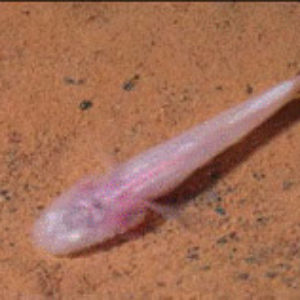calsfoundation@cals.org
Southern Cavefish
aka: Typhlichthys subterraneus
The southern cavefish (Typhlichthys subterraneus) is one of the two species of blind cave fishes found in Arkansas. The other is the Ozark cavefish. The southern cavefish is found in the subterranean waters of two major non-overlapping ranges separated by the Mississippi River: in the Ozark Plateau of central and southeastern Missouri and northeastern Arkansas and in the Cumberland and Interior Low plateaus of northwest Alabama, northwest Georgia, central Tennessee, and Kentucky. They are usually found at considerable depths (mostly between 175 and 240 meters below the land surface).
This species, which can grow as long as ninety millimeters, has a large, broad head. The caudal fin has from zero to two rows of sensory papillae (one on the upper half and the other on the lower half) and a vertical basal row. The anus is well in front of the anal fin in adults. They display simple eyes hidden under the skin. The body is depigmented, with some non-functional pigment cells. Under exposure to white light, some individuals develop pigment cells in the skin (epidermal melanophores). This suggests that their morphology is variable under different environmental conditions, a phenomenon known as phenotypic plasticity. This has also been observed among other cave fishes. The southern cavefish has a swim bladder and numerous sensory cells (neuromasts) in the body. They also have many small and unicuspid teeth.
Members of this species live for a long time (possibly even for decades) and grow slowly. Breeding probably occurs between April and May in association with rising water levels. As many as fifty percent of the adult females of a population may breed in any one year. They become reproductively active at twenty-two to twenty-four months of age. Fecundity is very low, perhaps fewer than fifty eggs (ova) per female. It takes about two months for free-swimming young to develop from the fecundated (zygote) stage. Females display parental care.
Southern cavefish are found mostly in flowing waters and seem to be attracted to point sources of water resurgences. They display strong preference substrates with large stones. They may use the larger interstices in between the pebbles to protect them from predators such as cave crayfishes as well as from strong currents. Southern cavefish tend to rest motionless on the bottom for long periods of time, feeding mostly on small crustaceans. Estimations of population sizes based on sightings at a single cave yield very low numbers: usually fewer than 150 individuals.
For additional information:
Green, Steven M., and Aldemaro Romero. “Responses to Light in Two Blind Cave Fishes (Amblyopsis spelaea and Typhlichthys subterraneus) (Pisces: Amblyopsidae).” Environmental Biology of Fishes 50 (October 1997): 167–174.
Robison, Henry W., and Thomas M. Buchanan. Fishes of Arkansas. 2nd ed. Fayetteville: University of Arkansas Press, 2020.
Romero, Aldemaro. “Percopsiformes (Trout, Perches and Relatives).” In Grzimek’s Animal Life Encyclopedia. 2nd ed. Vol. 5, Fishes II. Edited by Michael Hutchins, Dennis A. Thoney, Paul V. Loiselle, and Neil Schlager, eds. Farmington Hills, MI: Gale Group, 2003.
———. “Pisces (Fishes): Amblyopsidae.” In Encyclopedia of Cave and Karst Science. Edited by John Gunn. New York: Fitzroy Dearborn, 2004.
———. “Threatened Fishes of the World: Typhlichthys subterraneus (Girard, 1860) (Amblyopsidae).” Environmental Biology of Fishes 53 (September 1998): 74.
Romero, A., M. S. Connor, and G. L. Vaughan. “Population Status of the Southern Crayfish, Typhlichthys subterraneus in Arkansas.” Journal of the Arkansas Academy of Science 64 (2010): 106–110. Online at http://libinfo.uark.edu/aas/issues/2010v64/v64a20.pdf (accessed April 25, 2022).
Woods, Loren P., and Robert F. Inger. “The Cave, Spring, and Swamp Fishes of the Family Amblyopsidae of Central and Eastern United States.” American Midland Naturalist 58 (July 1957): 232–256.
Aldemaro Romero
Arkansas State University
 Fish
Fish Southern Cavefish
Southern Cavefish 




Comments
No comments on this entry yet.